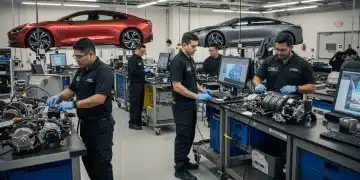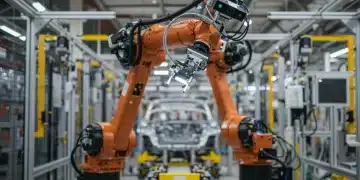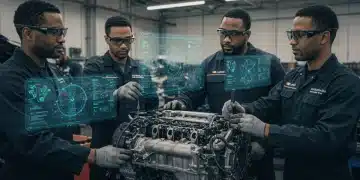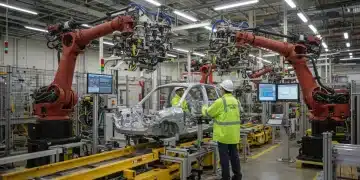Automotive Software Evolution: AI & ML Reshaping US Vehicle Performance by 2025
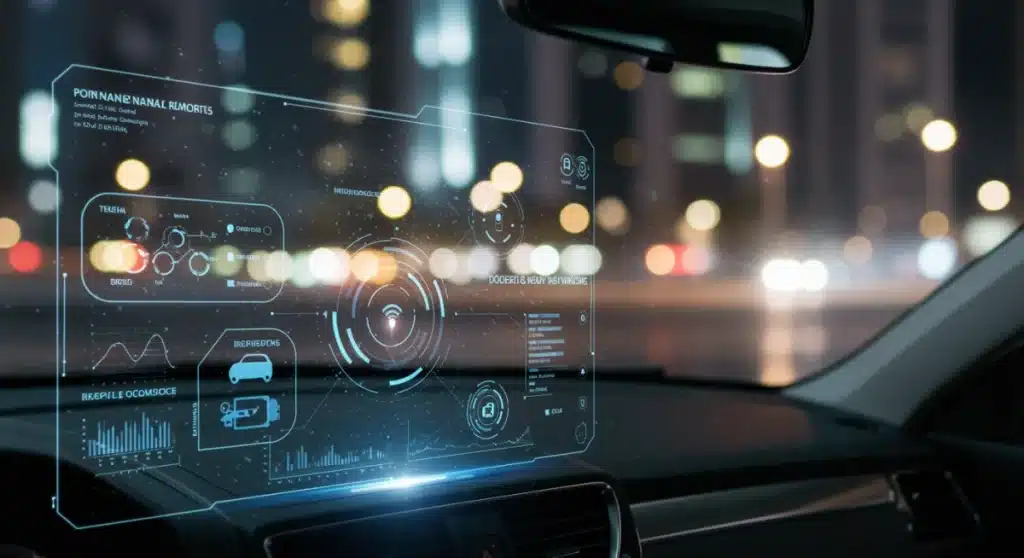
The landscape of the US automotive industry is undergoing a profound transformation. The Evolution of Automotive Software: How AI and Machine Learning are Reshaping US Vehicle Performance by 2025 is not just a trend but a foundational shift, promising smarter, safer, and more efficient vehicles on our roads.
The AI-Driven Revolution in Vehicle Systems
As of late 2023, artificial intelligence (AI) is no longer a futuristic concept but a present-day reality deeply embedded in automotive engineering. This integration is rapidly accelerating, redefining how vehicles operate and interact with their environment. By 2025, AI is expected to be a cornerstone of nearly all new vehicle architectures.
The shift towards software-defined vehicles means that much of a car’s functionality, from powertrain management to infotainment, is controlled and optimized by sophisticated algorithms. This allows for unprecedented levels of customization, over-the-air updates, and continuous performance improvements throughout a vehicle’s lifespan.
Enhanced Decision-Making and Adaptability
AI algorithms are dramatically improving a vehicle’s ability to make real-time decisions. This is crucial for advanced driver-assistance systems (ADAS) and, ultimately, autonomous driving. AI processes vast amounts of sensor data, identifying patterns and predicting potential hazards faster and more accurately than traditional systems.
- Predictive Analytics: AI anticipates maintenance needs, reducing unexpected breakdowns.
- Real-time Traffic Optimization: Algorithms adjust routes based on live traffic, minimizing travel time.
- Personalized User Experience: AI learns driver preferences for climate, entertainment, and seat positions.
Machine Learning’s Impact on Vehicle Performance
Machine learning (ML), a subset of AI, is particularly instrumental in enhancing vehicle performance. Unlike traditional programming, ML systems learn from data, continuously refining their models and improving accuracy over time. This iterative learning process is vital for the dynamic and unpredictable nature of real-world driving conditions.
From optimizing fuel efficiency to perfecting autonomous navigation, ML algorithms are at the forefront. They analyze millions of miles of driving data, identifying optimal parameters for engine control, braking, and steering, leading to smoother, safer, and more economical operation.
Continuous Improvement Through Data
The beauty of machine learning in automotive applications lies in its capacity for self-improvement. Every mile driven, every sensor reading, and every interaction with the driver generates valuable data that ML models can use to become more sophisticated. This data-driven approach ensures that vehicles become smarter over time, adapting to new challenges and environments.
- Adaptive Cruise Control: ML fine-tunes distance keeping and acceleration based on driving context.
- Advanced Object Recognition: Improved detection of pedestrians, cyclists, and obstacles in varying conditions.
- Battery Management: ML optimizes charging cycles and discharge rates for electric vehicles, extending battery life and range.
Autonomous Driving: The AI and ML Nexus
Autonomous driving represents the pinnacle of AI and ML integration in vehicles. Achieving Level 4 and Level 5 autonomy requires an intricate dance between perception, decision-making, and control systems, all powered by advanced software. By 2025, significant strides in this area are anticipated, with more widespread deployment of highly automated features.
The ability of AI to interpret complex scenarios, such as unexpected road construction or erratic driver behavior, and for ML to learn from these instances, is critical. This continuous learning loop is what will ultimately enable vehicles to navigate safely and efficiently without human intervention.
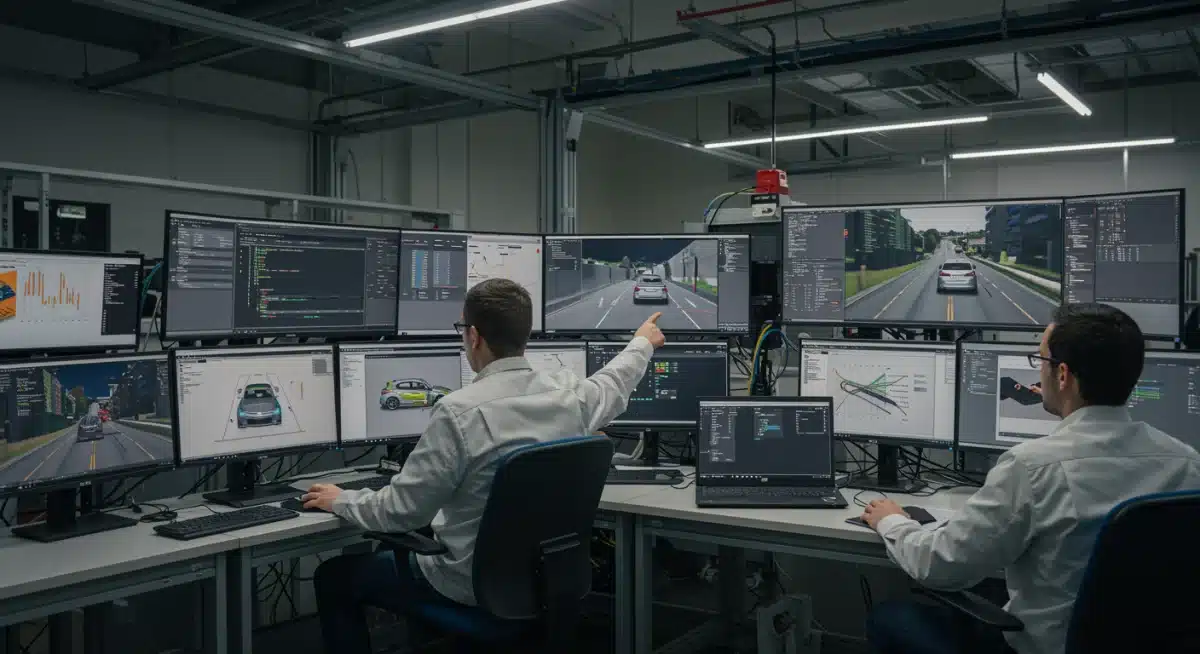
Challenges and Progress in Autonomy
While the promise of fully autonomous vehicles is immense, significant challenges remain. Regulatory frameworks, ethical considerations, and the sheer complexity of ensuring foolproof safety in all conditions are ongoing hurdles. However, advancements in sensor fusion, deep learning, and edge computing are rapidly addressing these issues.
Recent developments, as reported this past week, indicate accelerated testing and deployment of autonomous fleets in controlled urban environments, showcasing the rapid progress in the sector. This is laying the groundwork for broader adoption in the coming years.
Enhanced Safety and Reliability Through Software
Beyond autonomy, AI and ML are dramatically enhancing vehicle safety and reliability across the board. These technologies enable proactive safety measures, moving beyond reactive systems to anticipate and prevent accidents. This paradigm shift is set to significantly reduce road fatalities and injuries.
From advanced braking systems that react faster than humans to sophisticated occupant detection systems that optimize airbag deployment, software is becoming the primary driver of safety innovation. The reliability of these systems is continuously validated through extensive simulation and real-world testing, bolstered by ML’s ability to learn from millions of data points.
Proactive Safety Measures
AI-powered systems can detect driver fatigue, distraction, and even impending medical emergencies, alerting the driver or taking corrective action. This proactive approach to safety is a game-changer, transforming vehicles into vigilant guardians on the road.
- Driver Monitoring Systems: AI tracks eye movement and head position to detect drowsiness or distraction.
- Predictive Collision Avoidance: ML models assess potential collision risks and initiate evasive maneuvers or braking.
- Cybersecurity Enhancements: AI identifies and mitigates cyber threats to vehicle systems in real-time.
Connectivity and the Software-Defined Vehicle
The modern vehicle is increasingly a connected device, and this connectivity is inextricably linked to its software capabilities. The concept of the ‘software-defined vehicle’ (SDV) emphasizes that a car’s functionalities are primarily determined by its software rather than its hardware. This enables unprecedented flexibility, upgradability, and integration with external ecosystems.
AI and ML play a critical role in managing the vast amounts of data generated by connected cars, enabling everything from predictive maintenance to personalized in-car experiences and seamless integration with smart city infrastructure. This interconnectedness is paving the way for entirely new automotive services and business models.
Over-the-Air Updates and New Services
Over-the-air (OTA) updates, managed by sophisticated software, allow manufacturers to deploy new features, performance enhancements, and security patches remotely. This means vehicles can evolve and improve long after they leave the factory floor, extending their functional lifespan and enhancing consumer value.
Furthermore, connectivity enables a suite of new services, including advanced navigation with real-time data, remote diagnostics, and subscription-based features. These services are powered by AI and ML that analyze user behavior and vehicle data to offer tailored solutions.
Challenges and the Road Ahead for Automotive Software
While the benefits of advanced automotive software are clear, the path forward is not without its challenges. The increasing complexity of software systems demands robust cybersecurity measures to protect against hacking and data breaches. Additionally, ensuring the reliability and safety of AI/ML algorithms in all possible driving scenarios is paramount.
The industry is also grappling with the need for a skilled workforce capable of developing, testing, and maintaining these sophisticated systems. Collaboration between automakers, tech companies, and regulatory bodies will be essential to navigate these complexities and fully realize the potential of software-defined vehicles by 2025.
Addressing Key Hurdles
Addressing these challenges requires continuous investment in research and development, stringent testing protocols, and a commitment to transparency and ethical AI development. The regulatory landscape is evolving to keep pace with technological advancements, ensuring a safe and fair playing field for innovation.
- Cybersecurity: Developing impenetrable defenses against sophisticated cyber threats.
- Regulatory Frameworks: Establishing clear guidelines for autonomous vehicle testing and deployment.
- Talent Gap: Investing in education and training to build a skilled software engineering workforce for the automotive sector.
| Key Aspect | Brief Description |
|---|---|
| AI-Driven Systems | AI enhances real-time decision-making, predictive analytics, and personalized user experiences in vehicles. |
| Machine Learning Impact | ML optimizes performance, fuel efficiency, and critical safety functions through continuous data learning. |
| Autonomous Driving | AI and ML are foundational for advanced autonomous capabilities, enabling safe navigation and complex scenario interpretation. |
| Software-Defined Vehicles | Connectivity and OTA updates driven by software allow for continuous improvements and new service offerings. |
Frequently Asked Questions About Automotive Software Evolution
Today, AI is primarily enhancing US vehicle performance through advanced driver-assistance systems (ADAS), predictive maintenance, and personalized in-car experiences. It processes sensor data in real-time to improve safety, optimize routes, and manage vehicle systems more efficiently, making driving safer and more intuitive.
Machine Learning is crucial for future automotive safety by enabling predictive collision avoidance, sophisticated driver monitoring, and adaptive safety systems. ML models continuously learn from vast datasets, allowing vehicles to anticipate risks, detect driver impairment, and react more intelligently than ever before to prevent accidents.
While fully autonomous (Level 5) vehicles may not be common, highly automated features (Level 3 and 4) are expected to see significant expansion by 2025. These will include advanced self-driving capabilities in specific operational design domains, such as highways or designated urban areas, moving towards broader adoption.
OTA updates offer vehicle owners numerous benefits, including remote software enhancements, new feature additions, and security patches without a dealership visit. This keeps the vehicle’s software up-to-date, improves performance, and can even extend its functional lifespan, enhancing overall value and user experience.
Key challenges for automotive software development include ensuring robust cybersecurity against evolving threats, managing the immense complexity of integrated systems, and navigating a rapidly changing regulatory landscape. Additionally, addressing the talent gap for skilled software engineers remains a significant hurdle for the industry.
Looking Ahead
The rapid integration of AI and Machine Learning into automotive software is not merely an incremental improvement; it is a fundamental redefinition of what a vehicle is and what it can do. As we approach 2025, expect to see continued acceleration in these trends, with new vehicle models boasting unparalleled levels of intelligence, connectivity, and safety. The industry is poised for an era where software drives innovation, constantly elevating vehicle performance and user experience. Watch for further developments in regulatory frameworks and infrastructure adaptations, which will be crucial enablers for this ongoing revolution.
